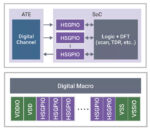In a major announcement at the 2025 Design Automation Conference (DAC), Siemens EDA introduced a significant expansion to its electronic design automation (EDA) portfolio, aimed at transforming how engineers design, validate, and manage the complexity of next-generation three-dimensional integrated circuits (3D ICs).… Read More
Podcast EP293: 3DIC Progress and What’s Coming at DAC with Dr. John Ferguson and Kevin Rinebold of Siemens EDA
Dan is joined by Dr. John Ferguson, Director of Product Management for the Calibre nmDRC and 3DIC related products for Siemens EDA. John has worked extensively in the area of physical design verification. Holding several patents, he is also a frequent author in the physical design and verification domain. Current activities … Read More
Arteris Expands Their Multi-Die Support
I am tracking the shift to multi-die design, so it’s good to see Arteris extend their NoC expertise, connecting chiplets across an interposer. After all, network connectivity needs don’t stop at the boundaries of chiplets. A multi-die package is at a logical level just a scaled-up SoC for which you still need traffic routing and… Read More
Altair at the 2025 Design Automation Conference #62DAC
Advancements in 3D Stacked IGZO 2T0C DRAM for Computing-in-Memory Applications
In the rapidly evolving field of artificial intelligence (AI), the demand for efficient data processing has exposed limitations in traditional memory technologies. The paper “3D Stacked IGZO 2T0C DRAM Array with Multibit Capability for Computing in Memory Applications,” published in Science Advances on May… Read More
Siemens EDA Outlines Strategic Direction for an AI-Powered, Software-Defined, Silicon-Enabled Future
In a keynote delivered at this year’s Siemens EDA User2User event, CEO Mike Ellow presented a focused vision for the evolving role of electronic design automation (EDA) within the broader context of global technology shifts. The session covered Siemens EDA’s current trajectory, market strategy, and the changing landscape … Read More
Synopsys Addresses the Test Barrier for Heterogeneous Integration
The trend is clear, AI and HPC is moving to chiplet-based, or heterogenous design to achieve the highest levels of performance, while traditional monolithic system-on-chip (SoC) designs struggle to scale. What is also clear is the road to this new design style is not a smooth one. There are many challenges to overcome. Some are … Read More
Design-Technology Co-Optimization (DTCO) Accelerates Market Readiness of Angstrom-Scale Process Technologies
Design-Technology Co-Optimization (DTCO) has been a foundational concept in semiconductor engineering for years. So, when Synopsys referenced DTCO in their April 2025 press release about enabling Angstrom-scale chip designs on Intel’s 18A and 18A-P process technologies, it may have sounded familiar—almost expected. … Read More
Alchip’s Technology and Global Talent Strategy Deliver Record Growth
Alchip Technologies Ltd., a global leader in high-performance computing (HPC) and artificial intelligence (AI) ASIC design and production services, continues its trajectory of rapid growth and technical leadership by pushing the boundaries of advanced-node silicon, expanding its global design capabilities, and building… Read More
Intel’s Foundry Transformation: Technology, Culture, and Collaboration
Intel’s historical dominance in semiconductor process technology began to erode around 2018, as competitors started delivering higher performance at smaller nodes. In response, Intel is now doubling down on innovation across two fronts: advanced process nodes such as Intel 18A and 14A, and cutting-edge packaging technologies.… Read More










The Quantum Threat: Why Industrial Control Systems Must Be Ready and How PQShield Is Leading the Defense